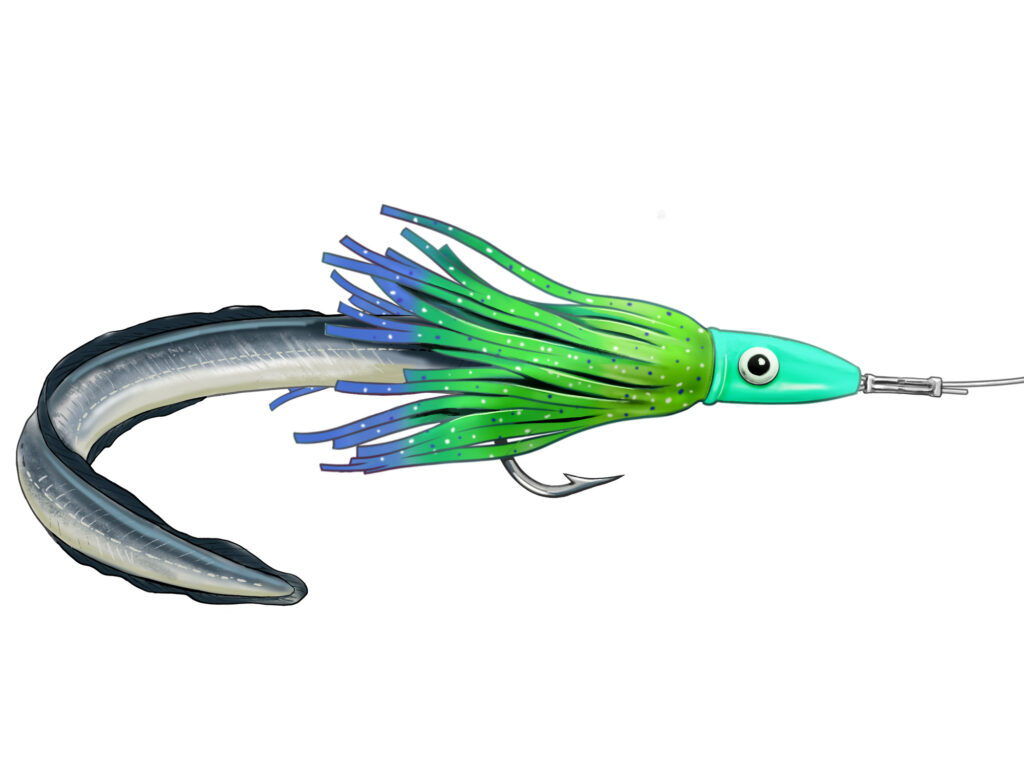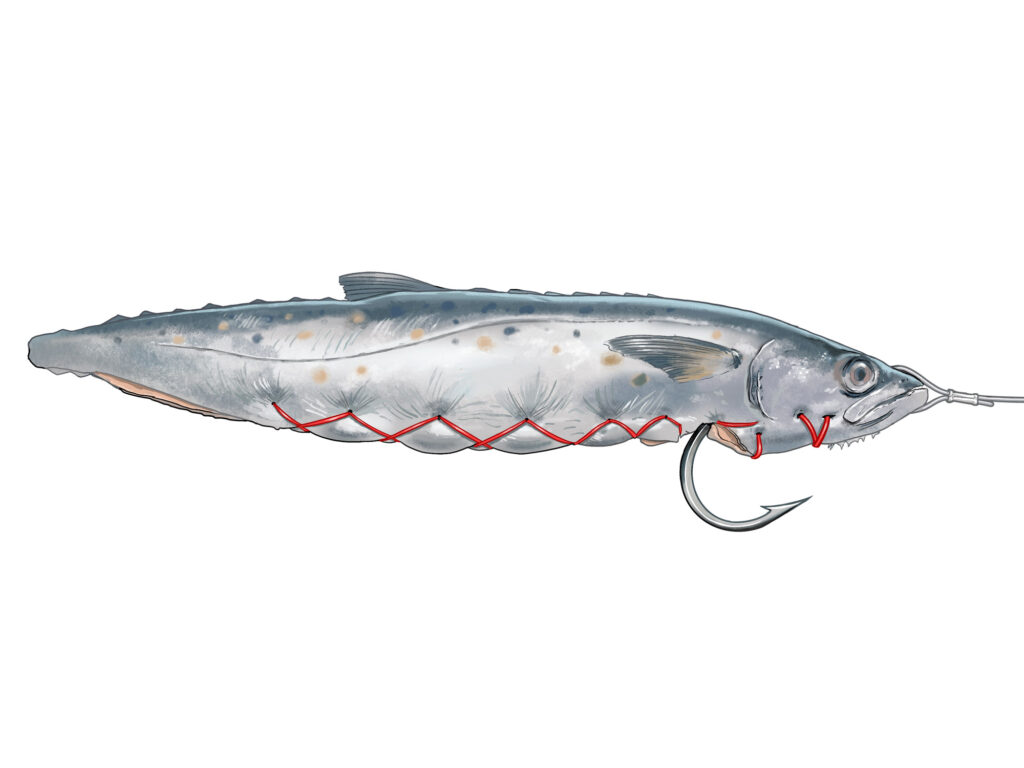The quickest bite I ever had while daytime swordfishing was on a bait I rigged almost as a joke. I took an entire fresh mahi, topped and tailed, completely deboned and gutted, and I made a fold-over bait and sewed squid inside of it. I was unable to confirm the chum-bag effect I was looking for because that bait got smoked seconds after dropping it down.
As a charter captain, artist and full-on weirdo, I love the creativity of making my own swordfish baits. Just about any properly rigged species will do the trick. Some of my favorites are strips, fillets and bellies of mahi, bonito and tuna. I also like whole mackerel, rainbow runners, squids and eels.
However, I wouldn’t be surprised if a sock full of squid was a productive bait, as long as it followed two main rules.
The Two Rules of Rigging for Swordfish

A squid skirt sewn onto a prepared swordfish bait adds extra movement and can streamline the bait to keep it from spinning. Steve Sanford
First, the hook must be secured to the bait. Utilizing rigging floss, ensure whatever bait you are using is stitched tightly to the hook. I start by crimping an 8-foot leader of 300-pound mono to a 9/0 to 11/0 hook, depending on the size of the bait. A 9/0 is usually the right size for an eel, whereas a 10/0 might fit best with a whole mackerel.
Regardless of the bait, pull the leader attached to the hook tight and sew it in with a rigging needle and 70-pound rigging floss so the hook doesn’t slide or flop around in the bait. Weave floss around the shaft and the eye of the hook to keep the bait from crumpling down the leader. You can also sew loops under the bottom of the hook and pull tightly to the back of the shaft. This gives the hook extra protrusion from the bait. The dance here is to make things as tight as possible without destroying the bait’s integrity.
The second rule is the bait must swim straight. No matter what you rig, test it before dropping it. Slowly troll the bait behind the boat, and make sure it doesn’t spin in the prop wash. If your bait isn’t gliding straight, sometimes minimal alterations can fix it quickly. Trimming down extra meat or clipping the tail off a whole rigged fish is sometimes all you need.
Sew on a Squid Skirt

Swordfish definitely eat whole squid baits, but they are soft and can break apart on the initial hit. Steve Sanford
As well as adding extra movement to the presentation, a squid skirt helps keep your bait streamlined and can cure spinning. Strips, eels, squids, whatever… I skirt everything.
Once the bait is rigged, slide the skirt down the leader to form a bait-hat and stitch it on. As with trolling skirts, the silicone tassels can bind up on the hook tip and interfere with a hookup. Trim the tassels away from the hook or just place the skirt well above the hook.
Rigged squid is a common bait for swords. It’s stinky, has movement, and is part of their natural diet. The problem with squid is it’s soft and often breaks apart after being hit. If you get a bite on the beginning of a long sword drift, you might be unsure when to check the bait, and checking the bait is a huge hassle when you’re fishing so deep. For this reason, I choose to drop squid on later drifts in the day if other baits are not working.
Tougher Baits Allow Longer Drifts

When constructing a bait from a whole fish, it should be butterflied, deboned and sewn back together around a properly secured hook. Steve Sanford
Eels, whole fish and fish strips withstand a lot more abuse and keep you in the game throughout the drift. Whole fish should be butterflied and deboned and then stitched back together after the hook has been properly affixed. As with eels, whole fish can be rigged with the leader crimped to the hook through the head. Place your hook in the fish with the eye of the hook in the bait’s mouth and the point protruding from its belly. Poke a hole through the top and bottom of the head and feed your leader through both the head and eyelet of the hook, adding the crimp in front of the mouth. This keeps your bait streamlined and avoids abrasion on the leader from the bait’s teeth.

Capt. Haddon said she wouldn’t be surprised if a sock full of squid was a productive swordfish bait, as long as it was rigged properly. Quinlyn Haddon
When rigging strips of meat you intend to fold over, trim your fillet as thinly as possible and stitch your hook and leader into the center of what will become the fold. Then fold it over like you’re closing a book, with the leader being a ribbon bookmark, and sew it shut. The bait should not be a fat roll like a sub sandwich, but more of a panini. With longer baits, I sometimes snip the end and turn it into meat tassels. There are many variations to stitching up different types of baits, all of which are viable when the two aforementioned rules are followed. Have fun with it and get creative!
Reference: [https://www.saltwatersportsman.com/howto/tips-rigging-swordfish-baits/]










